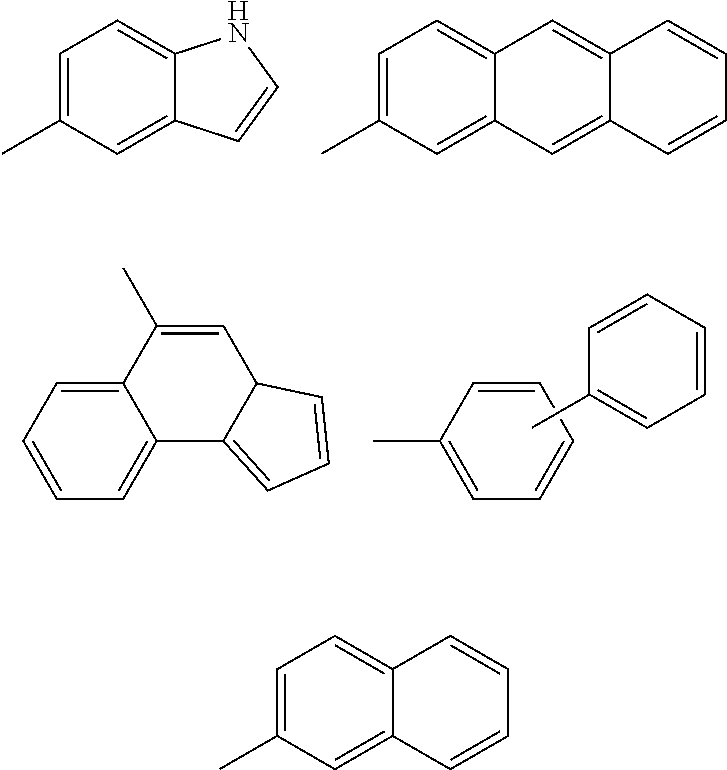Inhibitors of protein tyrosine kinase activity
a protein tyrosine kinase and inhibitor technology, applied in the direction of biocide, cardiovascular disorder, drug composition, etc., can solve the problems of limiting this approach, affecting the effect of vegf inhibitors as cancer therapeutics, vision loss, etc., to enhance the malignant behavior of cancer cells, promote motility and invasion, and enhance the growth of certain cancer cells
- Summary
- Abstract
- Description
- Claims
- Application Information
AI Technical Summary
Benefits of technology
Problems solved by technology
Method used
Image
Examples
example 12
N-(3-Fluoro-4-(2-(5((2-methoxyethylamino)methyl)-1-methyl-1H-imidazol-2-yl)thieno[3,2-b]pyridin-7-yloxy)phenylcarbamothioyl)-2-phenylacetamide (48)
Step 10. tert-Butyl (2-(7-(2-fluoro-4-(3-(2-phenylacetyl)thioureido)phenoxy)thieno[3,2-b]pyridin-2-yl)-1-methyl-1H-imidazol-5-yl)methyl(2-methoxyethyl)carbamate (47)
[0710]To a solution of 46 (375 mg, 0.711 mmol) in a mixture of EtOH (5 mL) and toluene (5 mL) at RT was added phenylacetyl isothiocyanate (189 mg, 1.066 mmol) and the reaction mixture was stirred at RT for 3 hours. The mixture was concentrated to dryness then purified by column chromatography (eluent a gradient of 80% EtOAc in hexane to EtOAc), to afford 47 (400 mg, 80%) as a red solid. MS (m / z): 705.2 (M+H).
Step 11. N-(3-Fluoro-4-(2-(5-((2-methoxyethylamino)methyl)-1-methyl-1H-imidazol-2-yl)thieno[3,2-b]pyridin-7-yloxy)phenylcarbamothioyl)-2-phenylacetamide (48)
[0711]To a solution of 47 (400 mg, 0.568 mmol) in toluene (10 mL) was added TFA (0.874 mL, 11.35 mmol) and the react...
example 13
N1-(3-Fluoro-4-(2-(5-((2-methoxyethylamino)methyl)-1-methyl-1H-imidazol-2-yl)thieno[3,2-b]pyridin-7-yloxy)phenyl)-N3-phenylmalonamide (49)
Step 1. tert-Butyl (2-(7-(2-fluoro-4-(3-oxo-3-(phenylamino)propanamido)phenoxy)thieno[3,2-b]pyridin-2-yl)-1-methyl-1H-imidazol-5-yl)methyl(2-methoxyethyl)carbamate (47a)
[0712]To a solution of 46 (333 mg, 0.631 mmol) in DMF (8 mL) at RT was added 3-oxo-3-(phenylamino)propanoic acid (226 mg, 2 eq, 1.262 mmol) and EDC (242 mg, 2 eq, 1.262 mmol), and the reaction mixture was stirred at RT for 24 hours. It was then concentrated to dryness then purified by column chromatography (eluent a gradient of 80% EtOAc in hexane to EtOAc), to afford 47a (357 mg, 82% yield) as a white solid. MS (m / z): 689.4 (M+H).
Step 2. N1-(3-Fluoro-4-(2-(5-((2-methoxyethylamino)methyl)-1-methyl-1H-imidazol-2-yl)thieno[3,2-b]pyridin-7-yloxy)phenyl)-N3-phenylmalonamide (49)
[0713]To a solution of 47 (357 mg, 0.518 mmol) in toluene (20 mL) was added TFA (0.799 mL, 20 eq, 10.36 mmol)...
example 14
N1-(3-Fluoro-4-(2-(5-((2-methoxyethylamino)methyl)-1-methyl-1H-imidazol-2-yl)thieno[3,2-b]pyridin-7-yloxy)phenyl)-N3-methyl-N3-phenylmalonamide (50)
[0714]Title compound 50 was obtained similarly to the compound 49 starting from the compound 46 (scheme 2) and using 3-(methyl(phenyl)amino)-3-oxopropanoic acid [US 2007 / 0004675 A-1] instead of 3-oxo-3-(phenylamino)propanoic) acid. Characterization of 50 is provided in the Table 1.
PUM
 Login to View More
Login to View More Abstract
Description
Claims
Application Information
 Login to View More
Login to View More - R&D
- Intellectual Property
- Life Sciences
- Materials
- Tech Scout
- Unparalleled Data Quality
- Higher Quality Content
- 60% Fewer Hallucinations
Browse by: Latest US Patents, China's latest patents, Technical Efficacy Thesaurus, Application Domain, Technology Topic, Popular Technical Reports.
© 2025 PatSnap. All rights reserved.Legal|Privacy policy|Modern Slavery Act Transparency Statement|Sitemap|About US| Contact US: help@patsnap.com



